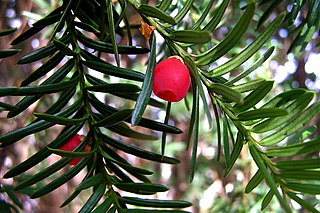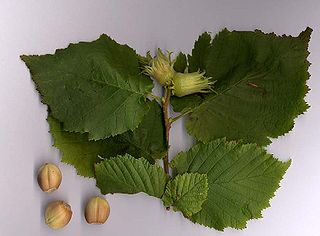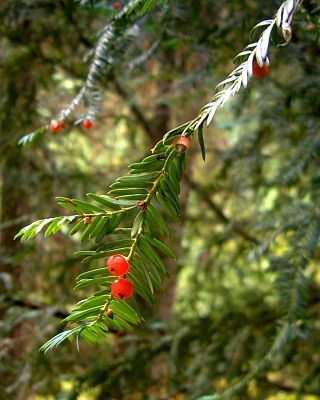
Taxus is a genus of coniferous trees or shrubs known as yews in the family Taxaceae. Yews occur around the globe in temperate zones of the northern hemisphere, northernmost in Norway and southernmost in the South Celebes. Some populations exist in tropical highlands.

Taxaceae, commonly called the yew family, is a coniferous family which includes six extant and two extinct genera, and about 30 species of plants, or in older interpretations three genera and 7 to 12 species.

An aril, also called an arillus, is a specialized outgrowth from a seed that partly or completely covers the seed. An arillode or false aril is sometimes distinguished: whereas an aril grows from the attachment point of the seed to the ovary, an arillode forms from a different point on the seed coat. The term "aril" is sometimes applied to any fleshy appendage of the seed in flowering plants, such as the mace of the nutmeg seed. Arils and arillodes are often edible enticements that encourage animals to transport the seed, thereby assisting in seed dispersal. Pseudarils are aril-like structures commonly found on the pyrenes of Burseraceae species that develop from the mesocarp of the ovary. The fleshy, edible pericarp splits neatly in two halves, then falling away or being eaten to reveal a brightly coloured pseudaril around the black seed.

Corylus avellana, the common hazel, is a species of flowering plant in the birch family Betulaceae, native to Europe and Western Asia. It is an important component of the hedgerows that were, historically, used as property and field boundaries in lowland England. The wood was traditionally grown as coppice, with the poles cut being used for wattle-and-daub building, and agricultural fencing.

Pinus contorta, with the common names lodgepole pine and shore pine, and also known as twisted pine, and contorta pine, is a common tree in western North America. It is common near the ocean shore and in dry montane forests to the subalpine, but is rare in lowland rain forests. Like all pines, it is an evergreen conifer.

The American badger is a North American badger similar in appearance to the European badger, although not closely related. It is found in the western, central, and northeastern United States, northern Mexico, and south-central Canada to certain areas of southwestern British Columbia.

Taxus baccata is a species of evergreen tree in the family Taxaceae, native to Western Europe, Central Europe and Southern Europe, as well as Northwest Africa, northern Iran, and Southwest Asia. It is the tree originally known as yew, though with other related trees becoming known, it may be referred to as common yew, European yew, or in North America English yew. It is a woodland tree in its native range, and it's also grown as an ornamental tree, hedge or topiary. Most parts of the plant are poisonous, with toxins that can be absorbed through inhalation, ingestion and through the skin; consumption of even a small amount of the foliage can result in death.
Pseudotaxus chienii, the whiteberry yew, is a species of plant in the yew family, Taxaceae. It is the sole species in the genus Pseudotaxus, but closely related to the other yews in the genus Taxus. It is endemic to southern China, occurring in northern Guangdong, northern Guangxi, Hunan, Southwest Jiangxi and southern Zhejiang.

Taxus cuspidata, the Japanese yew or spreading yew, is a member of the genus Taxus, native to Japan, Korea, northeast China and the extreme southeast of Russia.

Taxus brevifolia, the Pacific yew or western yew, is a species of tree in the yew family Taxaceae native to the Pacific Northwest of North America. It is a small evergreen conifer, thriving in moisture and otherwise tending to take the form of a shrub.

Peavy Arboretum is an arboretum operated by Oregon State University and located on Arboretum Road, Corvallis, Oregon. It is open to the public daily without charge.

Deosai National Park is a high-altitude alpine plain and national park located between the Skardu District, Kharmang District and Astore District in Gilgit-Baltistan, Pakistan.

Narkanda is a town and a nagar panchayat in Kumarsain subdivision of Shimla district in the Indian state of Himachal Pradesh. It is at an elevation of 2708 meters on the Hindustan-Tibet Road in Himachal Pradesh, India within a fir forest. It is about 60 km away from Shimla and surrounded by the Himalayan Range.
Taxus celebica is a large, evergreen shrub or tree of the yew family (Taxaceae), widespread in China at elevations up to 900 meters. It is commonly called Chinese yew though the term also refers to the Taxus chinensis or Taxus sumatrana.

Taxus chinensis is a species of yew. It is commonly called the Chinese yew, though this term also refers to Taxus celebica or Taxus sumatrana.

The Western Himalayan subalpine conifer forests is a temperate coniferous forests ecoregion of the middle and upper elevations of the western Middle Himalayas of Nepal, India, and Pakistan.

Taxus × media, sometimes known simply as Taxus media, is a conifer created by the hybridization of English yew Taxus baccata and Japanese yew Taxus cuspidata. This hybridization is thought to have been performed by the Massachusetts-based horticulturalist T.D. Hatfield in the early 1900s.














